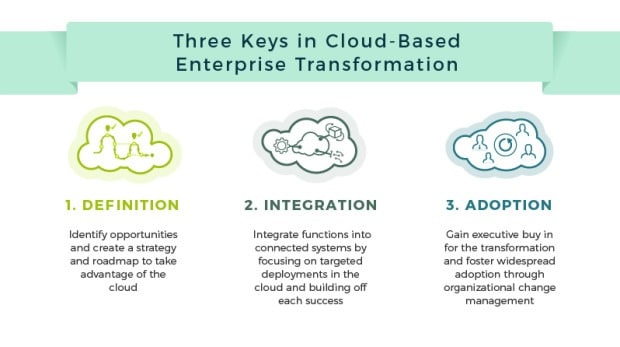
Moving back-end systems or front-office applications to the cloud can deliver data-driven insights, accelerate time-to-market and create great experiences for customers.
For global companies, it’s not enough for individual or regional business divisions to be fast and efficient. They need to be integrated. They need to be smart. Information must be visible and accessible, and it must flow freely across departments to enable timely decision-making.
One way to do this is through digital transformation, leveraging the cloud. In fact, moving back-end systems or front-office applications to the cloud can deliver data-driven insights, accelerate time-to-market and create great experiences for customers – but only when deployed correctly and adopted by all stakeholders. For many companies, this can be a challenge. Where do we start? What applications are most critical? How do we get everyone on board?
By following a strategic roadmap, companies can more easily identify a starting point and transition systems to the cloud over time, integrating as they go. This structured migration to the cloud can reduce the risks of “ripping and replacing” critical systems, or losing access to key data that can disrupt business even momentarily. It can create smarter systems, and more successful businesses.
The importance of pace in cloud transformation
A lack of vision can leave any business struggling to define the value of cloud, while an overly ambitious scope can derail progress. But equally important are having the right transformation leadership teams in place, and starting with effective planning to define the scope and timeline of your project.
In enterprise-wide digital transformations, this pace of change can make all the difference to success. Front-office departments, such as marketing, sales and services that can instantly demonstrate business benefits are often accepting and even eager to move to cloud. In comparison, back-office operations, such as finance and HR that are often encumbered with legacy systems and stringent regulatory guideline, and can be slower to buy in to change.
[ Related: Walmart’s Gigantic Private Cloud for Real-Time Inventory Control ]
One approach for success is to carefully plan targeted deployments in front-office operations first, then optimize and learn from these more visible and benefits-oriented changes. These early successes can be used to justify additional deployments and gain buy-in for changes in middle-office and back-office departments.
To maintain a steady pace of change, it’s also critical to take a careful approach to the process of change. This can be done by defining a strategy up front, integrating in a planned way and then putting adoption strategies in place. Let’s look at each of these steps and the role they plan in success.
- Definition: Your first step should be to identify opportunities to take advantage of the cloud in the most effective way. Create robust evaluation criteria, so the needs of the enterprise are met by the capabilities of the cloud platform. Envision how the cloud solution will translate into business transformation, and state it in clear objectives, benefits, and goals. Develop a comprehensive roadmap with the right activities, milestones, resources and budgets to realize change at the right pace.
- Integration: Start with targeted deployments of the cloud within the organization, whether enabling new systems or replacement systems. Focus on achieving meaningful milestones and moving at a pace that is viable and enables the organization to thrive. It’s important at this stage to show early results. Using real-time data enabled by new cloud deployments can help others in the organization see the value of the cloud, and identify points of connectivity that will be beneficial in their own jobs. Once a realistic scope is attained on an achievable timeline and results are shared, review in detail what worked and what didn’t, and then launch more broadly and optimize the process with each lesson learned.
- Adoption: Gain up front buy-in not only from the CEO and CFO, but also the CMO, COO, and other key leaders. Cloud deployment is a business initiative, so it’s key to communicate value in business terms to ensure transformative benefits are realized. Since user adoption is critical, this extends to organizational change management as well. Putting in the right incentives, training and programs to instill the right behaviors will ensure that all your stakeholders are eager (and even excited) to embrace the change. Finally, showing results at each stage can reinforce the value and further encourage others to support digital transformation.
Cloud transformation success at a major commerce systems company
One great example of success comes from the cloud journey of a large commerce systems company. After years of acquisitions and piecemeal technology implementations they realized that they could perform better with an integrated view of their entire enterprise—from front-office functions such as customer experience, to mid-office functions such as the supply chain, and back-office functions such as finance.
[ Related: Creating a More Strategic Multi-Cloud Environment ]
The vision was to become a smart enterprise, enabled through digital transformation, with strategic decision making supported by deep analytics. Such a transformation would be nearly impossible using traditional approaches because of long timelines and costly upfront investments. But, cloud provided the flexibility, speed, scalability and economics that made the transformation not just possible, but truly compelling.
They succeeded because the entire transformation was planned and paced. First, the company selected the right cloud platform to get the job done. The executive team gained buy in from the entire leadership team, including the CEO and CFO, and the scope of the project was carefully designed.
It was a massive cloud transformation, so the organization knew to pace itself through the process. They adopted the crawl/walk/run approach. By starting off slowly at a crawl, they ensured that each step was planned. They then learned to walk, and when they were confident in the solution’s performance, they ran – launching broadly and optimizing for performance.
[ Related: Cloud Communications: Why Hybrid Deployments Fall Short ]
Starting in the front office with customer experience, marketing and sales organizations allowed the transformation team to and work their way through the organization, letting initial cloud launches become successful in order to learn and justify further transformations in the business. They focused heavily on organizational change management, to train and persuade stakeholders, so they would be ready for changes to come.
With operations in 45 countries, the sheer size of the project was daunting. But with many transitions already underway, the company is already realizing benefits from this new end-to-end scalable model. Having a common platform has enabled them to streamline processes and reduce costs, while gaining visibility into operations with a single view of the truth. They are providing better services to customers, with the right products at the right place and time, to drive customer satisfaction, revenue and profitability.
Moving from cloud vision to business value
While technology continues to change how we run our businesses, a planned approach to digital transformation can provide visible benefits in terms of productivity, service and profitability. It can also provide a sound basis for convincing the rest of the organization to get onboard with larger transformational campaigns. When it comes to cloud, the right pace and process are key to finding success. Those that get it right will drive business impact today and be ready to adapt to whatever tomorrow holds.






























